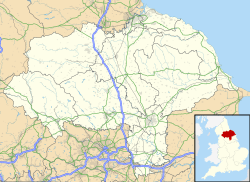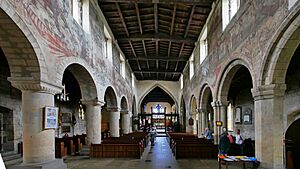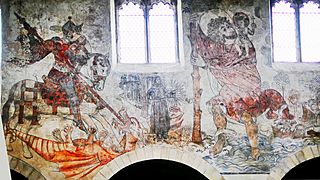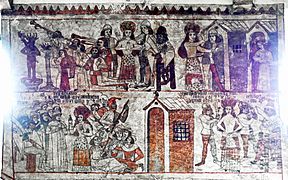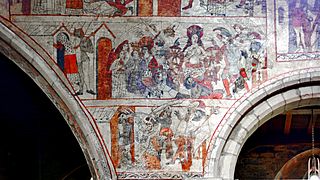St Peter and St Paul's Church, Pickering facts for kids
Quick facts for kids St Peter and St Paul, Pickering |
|
|---|---|
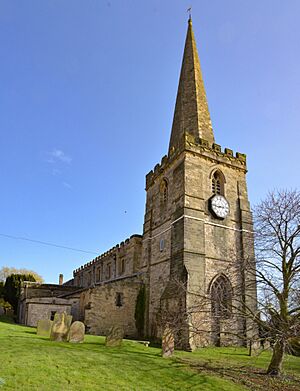
View from north west showing bell tower, spire, and north aisle
|
|
| 54°14′45″N 0°46′32″W / 54.2457°N 0.7756°W | |
| OS grid reference | SE7988884021 |
| Location | Pickering, North Yorkshire |
| Country | England |
| Denomination | Church of England |
| Previous denomination | Roman Catholic |
| Churchmanship | Anglo-Catholic |
| Website | www.pickeringchurch.com |
| History | |
| Status | Parish church |
| Founded | Saxon Period |
| Dedication | St Peter and St Paul |
| Architecture | |
| Functional status | Active |
| Heritage designation | Grade I |
| Designated | 24 October 1950 |
| Architectural type | Church |
| Style | Norman, English Gothic |
| Administration | |
| Parish | Pickering |
| Deanery | Northern Ryedale |
| Archdeaconry | Archdeaconry of Cleveland |
| Diocese | Diocese of York |
| Province | Province of York |
The Church of St Peter and St Paul is a very old and important church in the market town of Pickering. Pickering is located in North Yorkshire, England. This church sits on a small hill, and its tall spire can be seen from far away across the Ryedale area. It belongs to the Church of England and is part of the Diocese of York. The church is famous for its amazing collection of medieval wall paintings. It is also a Grade I listed building, which means it is a very important historic place.
Contents
History of the Church Building
Early Beginnings and Norman Style
People believe the first church on this spot was built during the Anglo-Saxon times. This was a very long time ago, before the year 1066. We do not know much about that first church. However, you can still see parts of it inside the current building. These include an old stone font and a carved cross piece.
The church was rebuilt around the year 1140. This new building had a style called Norman. Over the next few decades, more parts were added. A north aisle was built in 1150, and a south aisle was added in 1190. An aisle is a passage along the side of a church. You can still see the beautifully carved stone tops of columns from this time.
Changes and Additions Over Time
Around the year 1200, big changes happened because the church's central tower fell down. A new tower was built, but this time it was placed at the west end of the church. Later, a tall, pointed spire was added to this new tower.
In 1300, the chancel was made larger. The chancel is the part of the church where the altar is. It was made bigger to fit the more detailed church services of that time. This is why the east end of the church is wider than the main part, called the nave.
Special Chapels and Windows
The church also has two special small chapels called chantry chapels. These were built on the north and south sides of the altar area. The north chapel was built in 1337. It once held a statue of a knight named Sir William Bruce. His remains were later moved to make space for the church organ.
The south chapel was built in 1407. This chapel still has two statues of Sir David and Dame Margery Roucliffe. They are still in their original places.
The last major changes to the church building happened in the 1400s. The walls of the nave were made taller. New windows, called clerestory windows, were added high up on the walls. It was on these new, taller walls that the famous wall paintings were created.
The Pickering Wall Paintings
The Pickering Wall Paintings are a truly special collection of old murals. Murals are paintings done directly on a wall. These paintings cover most of the walls in the nave of Pickering Parish Church. They are found above the arches and between the high windows. These paintings are some of the best preserved and most complete medieval murals in the whole United Kingdom. They make the church famous both in England and around the world.
How the Paintings Were Hidden and Found
The paintings were likely finished around 1450. However, about 100 years later, during a time called the Edwardian Reformation, they were covered up. This probably happened around 1547. People thought these paintings were no longer needed in churches.
The discovery of the paintings in 1852 was an accident! Some plaster fell off the wall, revealing the colorful art underneath. The vicar at the time, Reverend John Ponsonby, did not like the paintings. He insisted they be covered up again, even though the Archbishop of York, Dr Thomas Musgrave, was upset about it. Reverend Ponsonby had someone sketch the paintings, but then he had them painted over with whitewash.
Luckily, in 1876, a new vicar named Reverend G. H. Lightfoot decided to uncover and restore the paintings. Thanks to him, we can see them today!
What the Paintings Show
The paintings cover most of the nave walls. They tell stories from the liturgical calendar, which is the church's yearly cycle of events. They show scenes from the lives of saints. They also show important Christian themes, like the life of Jesus and the "Works of Mercy."
On the north wall, from left to right, you can see:
- St George and the Dragon
- St Christopher carrying the Child Jesus
- The Beheading of John the Baptist
- Above that, an image of the Coronation of the Virgin by the Holy Trinity
- The stories of how popular English saints, St Edmund and St Thomas Becket, died for their beliefs.
On the south wall, from right to left, you can see:
- Scenes from the story of St Catherine of Alexandria
- The Seven Corporal Works of Mercy, which are acts of kindness like feeding the hungry or visiting the sick.
- Scenes from Jesus's life, including his suffering, his return to life, and the Harrowing of Hell.
- Pickering Wall Paintings (north wall)
-
St George and the Dragon and St Christopher carrying the Child Jesus.
-
Coronation of the Virgin by the Holy Trinity in the presence of the martyred Apostles.
-
Martyrdom of St Edmund.
- Pickering Wall Paintings (south wall)
See also
- Grade I listed buildings in North Yorkshire (district)
- Pickering Castle
- The Raunds Wall Paintings
- The Slapton Wall Paintings


